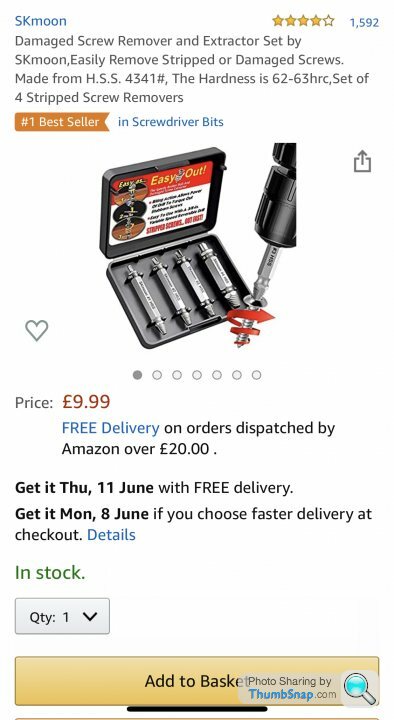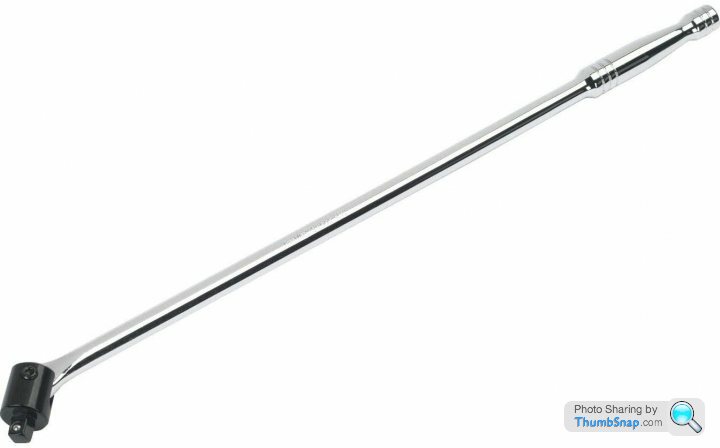Inlet Manifold screw broken
Discussion
Hello,
I had the heads of my 2,8i redone, and during assembly I put the wrong inlet manifold screw into the wrong place and it snapped off inside the block. It was a bit longer than the correct one and I thought it needed a nudge..
It is the screw closest to the back end of the engine. Sadly nothing is protruding so I have to try to weld something on or drill it out.
Is there any way the manifold will not be leaky with the screw missing?
If I try to get the screw out I might as well take the crankshaft and pistons out to be sure that I clean it all up before reassembly. Is that a bad idea? Will I have to replace all kinds of bearings and other stuff once I take the internals apart?
Thanks for reading.
I had the heads of my 2,8i redone, and during assembly I put the wrong inlet manifold screw into the wrong place and it snapped off inside the block. It was a bit longer than the correct one and I thought it needed a nudge..
It is the screw closest to the back end of the engine. Sadly nothing is protruding so I have to try to weld something on or drill it out.
Is there any way the manifold will not be leaky with the screw missing?
If I try to get the screw out I might as well take the crankshaft and pistons out to be sure that I clean it all up before reassembly. Is that a bad idea? Will I have to replace all kinds of bearings and other stuff once I take the internals apart?
Thanks for reading.
Definitely don't leave it and hope for the best. Really annoying if you refit the motor and it leaks air as you will never get the Kjet to work properly. Ask me how I know :-)
I've had success removing snapped studs by using the type of self centring drill bits used to mount domestic doors and very carefully drilling down slowly using high quality, left hand, drill bits and grease to catch the bits of swarf.
Once you have a hole through the screw you can open it out with successively bigger drill bits and then tap the remaining threads, but often they fall out when you get a decent hole through the middle (assuming these are not old, corroded screws).
Here's what I have: https://www.amazon.co.uk/Centering-Window-Cabinet-...
I've had success removing snapped studs by using the type of self centring drill bits used to mount domestic doors and very carefully drilling down slowly using high quality, left hand, drill bits and grease to catch the bits of swarf.
Once you have a hole through the screw you can open it out with successively bigger drill bits and then tap the remaining threads, but often they fall out when you get a decent hole through the middle (assuming these are not old, corroded screws).
Here's what I have: https://www.amazon.co.uk/Centering-Window-Cabinet-...
As you've only just put the stud in you may be able to get the stump out with an EZYout type tool but that will depend on being able to drill a well centered hole down the middle of the stud. Not easy when the head is on the engine in the car. It might be easier in the long run to take the head off again.
wamba said:
it snapped off inside the block
If I try to get the screw out I might as well take the crankshaft and pistons out to be sure that I clean it all up before reassembly.
Is the stud in the head or the block? Sure the manifold bolts to the head, which can be removed without any mucking about with the bottom end. You maybe could drill out the hole without removing the heads, but there would be a high risk of dropping swarf into the valley. IMO the time taken to remove the head would be well spent.If I try to get the screw out I might as well take the crankshaft and pistons out to be sure that I clean it all up before reassembly.
88S1 said:
Surely the screw extractor has to be the first thing to try, got nothing to lose trying this and without doubt the simplest solution. If it doesn’t work then try one of the other methods.
The problem is that the bolt has bottomed, and then some... if the full diameter bolt broke with that force, it's going to take some mighty strong extractor to shift it at somewhat less than full d.Unless you're really experienced at drilling this sort of thing out, I'd recommend looking for a local 'Thread Doctor' or Thread Wizard'.
Just how much force did you use? Surely if you used hand tools to put the stud in then you should be able to apply the same force in reverse to get it out. It won't be rusted in. If you can't get a decent quality stud extractor into the stud then welding the washer and nut on seems like the best option.
Not too much joy to be honest! I took the heads off and tried to get it out with an extractor, but it just sheared off metal from the screw and did not help. I tried to drill it out, but didn't manage to center it just right so I left it at that. Guess I have to find someone with the right toolset to drill the whole thing out and redo it?
And I didn't use a lot of force, it was a similar tool but I had set the torque pretty low. It was just that the screw was already fully in as it was the longer one where I should have used the shorter. Small mistake, big pain in the ***.
Thanks for all the helpful comments though!
And I didn't use a lot of force, it was a similar tool but I had set the torque pretty low. It was just that the screw was already fully in as it was the longer one where I should have used the shorter. Small mistake, big pain in the ***.
Thanks for all the helpful comments though!
wamba said:
I tried to drill it out, but didn't manage to center it just right so I left it at that.
Don't need to drill dead centre. Keep upping the drill size until just catching the threads in the casting then you should be able to pick remains of stud out with a tiny chisel, old screwdriver, pointy thing, whatever?If you drill to the very bottom it should release the 'tension' and remains will come out quite easy?
Grease, magnets, rag to catch swarf and a magnetic sump plug to catch anything that does drop to the sump

May have missed it but is this broken stud into a head or the block?
wamba said:
The broken stud is inside the block. It's too deep down to weld anything on top, and it all looks so shiny that I can't identify where the screw ends and the block begins. I guess I could drill some more and just try.
I've never seen it done in person, but there is a technique where you put a tube into the hole which is a clearance on a welding rod, and weld the tube to the broken screw like that. The welding rod flux saves it from shorting against the tube so you can weld at the bottom of a small hole..Your profile doesn't say where you are, but if in the South I would (as before) recommend the Thread Wizard/Doctor type chaps, and I cannot believe that there are not franchises/ similar business models elsewhere. This is exactly the kind work they do all day every day, getting the trade mainly out of a hole (sorry!), and the best part is that they will come to you. Believe me, what to you is a massive problem is probably the simplest job they'll see all week.
(I am in no way connected to the above businesses, but I have seen the Thread Wizard in action.)
(I am in no way connected to the above businesses, but I have seen the Thread Wizard in action.)
This fella shows you how to use the centering devices. Bit of grease and a magnet to catch the bits, use a left hand drill bit, should be easy to do - I've done dozens like this (mainly old MG exhaust manifold studs!)
https://www.youtube.com/watch?v=dJfkCj3FWBs
https://www.youtube.com/watch?v=dJfkCj3FWBs
Gassing Station | S Series | Top of Page | What's New | My Stuff







